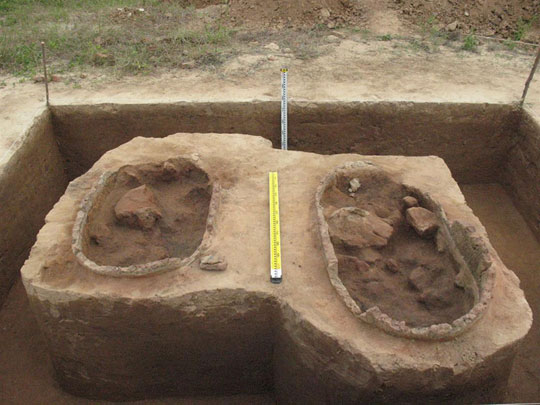The first terracotta kiln burial site in Vietnam
According to the artifact assessment results of the Vietnam Institute of Archeology, the terracotta burial remains have been discovered in Tan An village, Xuan Son Nam commune, Dong Xuan mountainous district (Phu Yen province). Great since the 13th century.
On December 22, Deputy Director of the Department of Culture and Sports and Tourism of Phu Yen Province Phan Dinh Phung said that Xuan Son Nam's kiln-grave relic was discovered after the historic flood of 3,725m 2 in 2009. .

Xuan Son Nam furnace-grave relic. (Source: Internet)
At the end of October 2010, the Vietnam Institute of Archeology collaborated with Phu Yen province to excavate a part of the relic area. Here, the excavation team has discovered a series of large artifacts of rhombic terracotta, with a length of 1.5-2m; 0.8-1m wide. Inside these objects are vestiges of burnt ash and human bones.
With the above results, scientists believe that this is the first terracotta burial site discovered in Vietnam and their owners are Cham people.
The monument represents the cremation customs inside the Cham earthen grave in the historical and cultural period around the 13th century. This enriches the Cham culture that once existed on Phu land. Yen
According to Mr. Phan Dinh Phung, with the above uniqueness, Xuan Son Nam terracotta burial site should be preserved. Phu Yen province needs support from ministries, branches at the central level and abroad to continue studying this relic.
Currently, the terracotta kiln-burial site has not been implemented any preservation measures. The relic area is close to the right bank of Ky Lo river, one of the big rivers and has complicated terrain terrain, the relic area is prone to landslides.
Together with the Xuan Son Nam terracotta burial site, in Phu Yen, scientists have found many ancient Cham monuments with cultural values, great history and unique characteristics.
Cham Tower at the top of Mount Nhan (Tuy Hoa city) dates back to the 11th century; Nui Ba relic (Tay Hoa district) dates back to the 13th century. Opposite Nui Ba relic, on the left bank of Ba river is the Ho Chi Minh relic dating from the 5th century to the 15th century. , 16 when Vietnamese people started arriving in this land .
Especially in other localities, Cham cultural relics are often found on the right bank of the rivers when the Kingdom of Champa is under pressure of migration from the North. Particularly in Phu Yen, there still exist relics on both sides of the river that go through the same historical period.
- An odd ancient tower tomb population in Peru
- Detecting a thousand-year grave population of Sa Huynh residents
- Peru: Discovery of a large pre-Inca burial site
- New discovery of terracotta army in the tomb of Qin Shihuang
- Coal tunnel kiln from exhaust gas
- The goal is that few people know of burial on trees
- The deadly weapon of the terracotta army, the tomb of Qin Shi Huang
- 'Eco-friendly' burial is becoming a trend!
- China unearthed dragon-shaped kilns over 1200 years
- Mexico discovered an ancient burial site dating back to 800 years
- My mother hugged me for 6,000 years in the Netherlands
- Unusual burial practices in Tibet
 Discovered an ancient centipede fossil 99 million years old
Discovered an ancient centipede fossil 99 million years old Discovered bat-like dinosaurs in China
Discovered bat-like dinosaurs in China Discovered a 200-year-old bronze cannon of the coast
Discovered a 200-year-old bronze cannon of the coast Discover 305 million-year-old spider fossils
Discover 305 million-year-old spider fossils